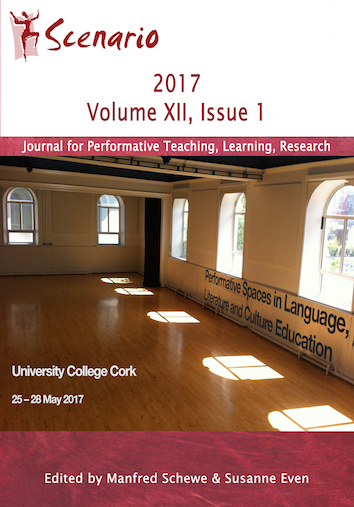Presenting as Performance: Painless Practices for Presentation in Foreign Languages
DOI:
https://doi.org/10.33178/scenario.11.1.4Abstract
Presenting is a complex task for language learners. It requires them to acquire and read material, extract main points and express them in their own words in the target language, listen to other presenters and react appropriately with good questions and comments – and, of course, speak out loud while presenting. Language learners activate all these skills on a daily basis in the language classroom. However, speaking out loud in front of a group about one specific topic for an extended period of time is usually not part of the daily routine and therefore demands special attention, care, and action. This article models a sequence for preparing, planning, practicing, delivering, and evaluating presentations and briefly discusses the role of visual slides, but focuses on speaking exercises and explains how they strengthen the presenters both as language learners and as performers. Two theater theories form the backbone to these exercises: Konstantin Stanislavski’s “system”, and Keith Johnstone’s improvisation theater concept of status.The article describes each step of a practice sequence, including warm-up exercises, prompts for constructive peer feedback, and rubrics for (self-)evaluation, and reflects on the overall benefits of their inclusion in the language classroom.References
Beiseler, Miriam (2004): Akademisches Klopfen. Deutsche Welle. 9. Mai 2004. http://www.dw.com/de/akademisches-klopfen/a-1190176 [last accessed June 2, 2017]
Blanckenburg, Max von & Haack, Adrian (2016): Get Your Point Across. Mit dramapädagogischen Methoden monologisches Sprechen und language awareness fördern. In: Der fremdsprachliche Unterricht Englisch 142, 32-37
Bo Wang, Timothy Teo & Shulin Yu (2017): Teacher feedback to student oral presentations in EFL classrooms: a case study. In: Journal of Education for Teaching. International Research and Pedagogy 43/2, 262-264 http://www.tandfonline.com.libezproxy2.syr.edu/doi/abs/10.1080/02607476.2016.1257507 [last accessed June 2, 2017]
Council of Europe (2001): Common European Framework of Reference for Languages: Learning, teaching, assessment. Cambridge: University Press. https://rm.coe.int/CoERMPublicCommonSearchServices/DisplayDCTMContent?documentId=0900001680459f97 [last accessed June 2, 2017]
Cuddy, Amy (2012): Your Body Language Shapes Who You Are. TED Talk. Edinburgh 2012. https://www.ted.com/talks/amy_cuddy_your_body_language_shapes_who_you_are [Last accessed June 2, 2017]
Deep, Samir S. & Motulsk, Arno G (2005): Red-Green Color Vision Defects. In: GeneReviews. https://www.ncbi.nlm.nih.gov/books/NBK1301/ [last accessed June 2, 2017]
Duarte, Nancy (2008): Slideology: The Art and Science of Creating Great Presentations. Boston: O’Reilley
Gallo, Carmine (2015): Talk Like TED: The 9 Public-Speaking Secrets of the World’s Top Minds. New York: St. Martin’s Griffin.
Hernández-Julian, Rey & Peters, Christian (2015): Student Appearance and Academic Performance. http://www.seksonderzoek.be/wp-content/uploads/2016/01/Student-Appearance-and-Academic-Performance-_v3.pdf [last accessed June 2, 2017]
Johnstone, Keith (1987): Impro: Improvisation and the Theatre. London: Routledge
Reynolds, Garr (2008): Presentation Zen: Simple Ideas on Presentation Design and Delivery. San Francisco: New Riders
Reynolds, Garr: (2010): The Naked Presenter: Delivering Powerful Presentations with or without Slides. San Francisco: New Riders
Roam, Dan (2008): The Back of the Napkin: Solving Problems and Selling Ideas with Pictures. New York: Portfolio Hardcover
Spolin, Viola (1986): Theater Games for the Classroom. A Teacher’s Handbook. Evanston, IL: Northwestern University Press
Stanislavski, Konstantin (2008): An Actor’s Work. A Student’s Diary. Translated and Edited by Jean Benedetti. London: Routledge
Stanislavski, Konstantin (2010): The Approach to a Role. An Actor’s Work on A Role. Translated and Edited by Jean Benedetti. London: Routledge
Wargo, Eric (2006): How Many Seconds to a First Impression? In: Association for Psychological Science (July 1, 2006). https://www.psychologicalscience.org/observer/how-many-seconds-to-a-first-impression#.WNhnFBi-JA4 [last accessed June 2, 2017]
Published
Issue
Section
License
Copyright (c) 2017 the author(s)

This work is licensed under a Creative Commons Attribution-NonCommercial-NoDerivatives 4.0 International License.







